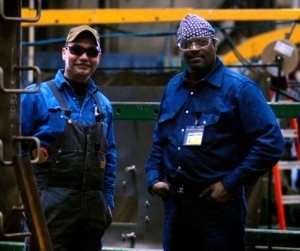 In my last post, I showed you a good example of all the things you can do wrong during a lean transformation. Learning from these mistakes gives a list of points that are relevant for a lean transformation. Let me show you what is important for a successful lean transformation.
In my last post, I showed you a good example of all the things you can do wrong during a lean transformation. Learning from these mistakes gives a list of points that are relevant for a lean transformation. Let me show you what is important for a successful lean transformation.
You Need to Convince Your People!
 Lean is not a tool but a culture. Hence, you have to convince your people that lean can help them. This is also often called a mindset change. This is fundamentally different from installing a machine or developing a new product. Those you can simply buy or develop. Once the machine or product is there, your people can’t undo it (or at least it is very difficult for the workers to have a product or machine removed).
Lean is not a tool but a culture. Hence, you have to convince your people that lean can help them. This is also often called a mindset change. This is fundamentally different from installing a machine or developing a new product. Those you can simply buy or develop. Once the machine or product is there, your people can’t undo it (or at least it is very difficult for the workers to have a product or machine removed).
Not so with lean manufacturing. Even many of the individual tools in lean manufacturing require cooperation and support by the people. If you want your people to stop the line if there is a problem, then they have to do it every single time. If you want to level your production, it needs constant attention by the people doing this task. The overarching concepts of PDCA and continuous improvement die on the spot if the people are not actively behind them. Hence, again, you need to convince your people!
Also, you do not need to convince everybody. This is impossible. If you randomly pick ten employees, there is probably at least one who is against the new idea in particular, and maybe even against the company in general. But you would need the support of the majority of your people.
How Do You Convince Your People?
 So now the question is, how do you convince your people? As we have seen in the last post, pressure, threats of unemployment, and a plant death match are not well suited to convince people of your ideas. This should be obvious, but apparently it is not always to all managers. Another popular approach is to simply tell your people that it is important. Maybe even put up some posters or similar. Or even hold a motivational seminar convincing your people of the new ways.
So now the question is, how do you convince your people? As we have seen in the last post, pressure, threats of unemployment, and a plant death match are not well suited to convince people of your ideas. This should be obvious, but apparently it is not always to all managers. Another popular approach is to simply tell your people that it is important. Maybe even put up some posters or similar. Or even hold a motivational seminar convincing your people of the new ways.
Unfortunately, this rarely works either. Many workers in industry have long since learned to ignore the background noise, ignoring what the bosses say, and instead look at what the bosses do. Managers sometimes overestimate the weight of their words. Hence, such verbal emphasis usually has little effect. At best, such talks or posters could have a minor supporting role; at worst, they could turn the people against it, based on the outcome of the last program that was advertised by such phrases. If the previous three grand programs always made the mess bigger, then a poster announcing the fourth will meet with resentment.
The more trust management has with their people, the easier it will be. A company that uses management by fear will have more difficulties in a lean transformation. But even if your management only has a mediocre respect among the workers, a lean transformation can still be done. Done well, it even could increase the reputation of the management.
Start Small
 The above is quite a challenge. Luckily, there are things that make it easier. At the beginning, you do not need their conviction, but it suffices if they are willing to give it a try. Hence, try to get them onboard on an improvement project to test the waters. Make sure you pick a case that is both relevant to the workers and has a high chance of success. For subsequent projects you can build on this success. The more successful projects you complete, the more the people will trust in the method.
The above is quite a challenge. Luckily, there are things that make it easier. At the beginning, you do not need their conviction, but it suffices if they are willing to give it a try. Hence, try to get them onboard on an improvement project to test the waters. Make sure you pick a case that is both relevant to the workers and has a high chance of success. For subsequent projects you can build on this success. The more successful projects you complete, the more the people will trust in the method.
Involve Your People

Another VERY important part is to involve the workers in the lean transformation that affects their area. This has two main benefits. First, the chances of success are higher. Nobody knows the shop floor as well as the workers who work there every day. Access their knowledge to ensure the improvement actually works.
Second, the workers will have a higher level of trust if they were involved in the change. They distrust solutions that rain down from above without their involvement … and this distrust is often justified.
Of course, you cannot involve all employees in a lean transformation project. Depending on the topic, I find a group size of five to twelve people good. This should include representatives of different stakeholders, like management, engineering, maintenance, and especially the operators. As for operators, in most plants there are a few alpha males or alpha females who can shape the opinion of the group. Having them on the team and letting them help to develop a working solutions will make wonders toward the mindset of the whole plant.
Speak Their Language
 So, now let’s do a vertical-approach heijunkaing and jidokaing by getting the buy-in of the empowered stakeholders leveraging our core competency by thinking outside of the two bin kanban. I wrote this sentence, but, frankly, I don’t even know what that means! You need to speak a language the people understand. While buzzwords, consulting lingo, and Japanese vocabulary may (or may not) impress the management, it will definitely turn off the workers.
So, now let’s do a vertical-approach heijunkaing and jidokaing by getting the buy-in of the empowered stakeholders leveraging our core competency by thinking outside of the two bin kanban. I wrote this sentence, but, frankly, I don’t even know what that means! You need to speak a language the people understand. While buzzwords, consulting lingo, and Japanese vocabulary may (or may not) impress the management, it will definitely turn off the workers.
While I do have a good Japanese vocabulary, I actively try to avoid using this when doing workshops. Use plain English (or whichever language you are working in) whenever possible. Some of the positive feedback I get after trainings is that I did not use a single Japanese word during the entire day.
Make It Benefical for Them
Finally, the projects should be beneficial for the workers too. GM thought it would be beneficial to GM to fire 25% of the people, but for some reason, the workers disagreed, and the projects floundered. Especially at the beginning, select projects that have a positive impact on the shop floor.
Management Committment
 Finally, you need management committed. Managers are used to delegate tasks to others. After all, this is their primary job description, to manage others. However, you cannot delegate changing the corporate culture! While others can assist with some aspects of a lean transformation, it needs management support, not only passively allowing it, but actively driving it.
Finally, you need management committed. Managers are used to delegate tasks to others. After all, this is their primary job description, to manage others. However, you cannot delegate changing the corporate culture! While others can assist with some aspects of a lean transformation, it needs management support, not only passively allowing it, but actively driving it.
 Successful lean transformations as with Trumpf or Porsche had top-level managers that had not only the freedom to change but actively pushed their company in the right direction. At Toyota it was Taiichi Ohno, and at Trumpf, it was Mathias Kammüller. The latter learned lean through an extensive stay at a Bosch joint venture in Japan. He used this experience with lean to subsequently change Trumpf.
Successful lean transformations as with Trumpf or Porsche had top-level managers that had not only the freedom to change but actively pushed their company in the right direction. At Toyota it was Taiichi Ohno, and at Trumpf, it was Mathias Kammüller. The latter learned lean through an extensive stay at a Bosch joint venture in Japan. He used this experience with lean to subsequently change Trumpf.
Hence, the manager at the top also needs to learn lean. This doesn’t mean a theoretical knowledge of kanban, but actively leading lean projects. Lean is learning by doing. Like riding a bicycle, you can learn it only by actually … well … riding a bicycle. Books don’t help you much here. The more a manager understands and acts the lean culture, the more he or she will be able to help and drive a lean transformation.
On the opposite end, management by cost accounting is more likely to hinder lean. Often, the benefits of lean projects are hard to calculate. Anything that cost accounting can’t calculate is usually set to zero. If you believe this “zero,” then lean has no benefit, even though in reality it does.
Overall, there are many requirements to start a lean transformation. Lean is a culture, and it requires a mindset change, a change in culture. People are not machines (even though managers occasionally like to see them as such). Every person is different, and hence every plant has a different culture. What may work for one plant may not work for others. It is not like flicking a switch, but is a constant work on improving the culture. In my next post, I will talk more about how to structure such a lean transformation. Now, go out, convince your people of lean, and organize your industry!

I still confused when i read any question starting by the ‘HoW’ question, for my ‘mental map’ i wait for ‘process’ to be the answer of question so does the sequance :
-start small
-speak languange
-Involove
-make benefical
-etc..
is the ‘Elexir process’? lean is culture but what does culture mean is the ‘ptifall’ for any journey of transformation
depending on the hypothesis of the designer any transformation is ‘a mutation / évolution’ I like to use the ‘USER’ accronym
– Usefulness (make benefical)
-Simplicity (speak languange)
-Evolutionary ( the missed link learning as a base for the fibred space)
-Rapid (start small,)
Hi Mustapha,
such a “seven Step” approach or similar is only useful if the situation is always the same, as for example repairing a washing machine. When dealing with humans, you have to be more general, as every human is different. Sure, you can find “X steps to a lean transformation” out there, often starting with value streams. However, they exist because some people want them, not because they actually work!
Management ‘Involvement’? It needs to be stronger. I rather like the breakfast analogy – the chicken is involved …but the pig is committed!
Remember WIFM.
Hi Steve, good point. I have slightly reworded the article towards “Management Commitment”. Thanks!
In the Indian context, the management should think in terms of giving the employees their place in implementing lean. Most management try to push lean as a measure of cost cutting. The points given here are vital for gaining the support of internal customers. Seek to understand the internal customer and try to provide better workplace with ownership. The culture will change as if they are part of the organization and the lean movement will fetch benefit for the organization and self. Further, they should be motivated to match the personal vision with the organizational vision. The article has given remarkable inputs for Indian industry professionals to practice.
This is exactly the way I have followed when starting a new project in logistics, since 30 years ago, when I had no clue about what lean was. The day I came to a project for the first time, I was seen as a killer and people were reluctant to me. The most difficult task always is to convince some people, by discussing with them and using their language, to start a small project, easy and fast to implement, with secured success. A quick win. After that, general confidence increases; I am not seen as an enemy. New and more complex projects can be run.
By the way, you do not need to explain the benefits of an action; people will do for you. And results can be measured, of course.
Excellent post.
I’m not a lean expert.
8 years ago I participated in a culture change project, everyone was involved from the Vicepresident of the company to every single worker in 1 production line. Part of the training included math, technical drawing and machining, so the operator was triggered to think and understand critical assemblies and create and follow instructions. This helped a lot on the production line improvement. The respect to anyone who is in the meddle of a process is also important to prevent quality issues.
Best regards,
Hi Christoph,
Definitely a great position on managing a lean culture. My professor always states we should be lean thinkers in any situation and think small! Getting all parties involved in one culture really gets a project moving. I will keep this in mind while working on my Six Sigma Green Belt project.
Chris,
Great post! I feel like so many people could benefit from reading this piece. Wether you are making a lean transformation at work, or you are coaching a little league team, it is concepts such as these that gets the people around you enthusiastic! A great leader will always put themselves in the worker’s shoe, and see life from their perspective. People like to be respected and understood, and if you believe in people then they will believe in you! Trust can be so valuable, especially as a manager. Thank you for reminding everyone how to be a leader and make things happen! Go Lean!
Many thanks to all for commenting. I am glad you liked the article.